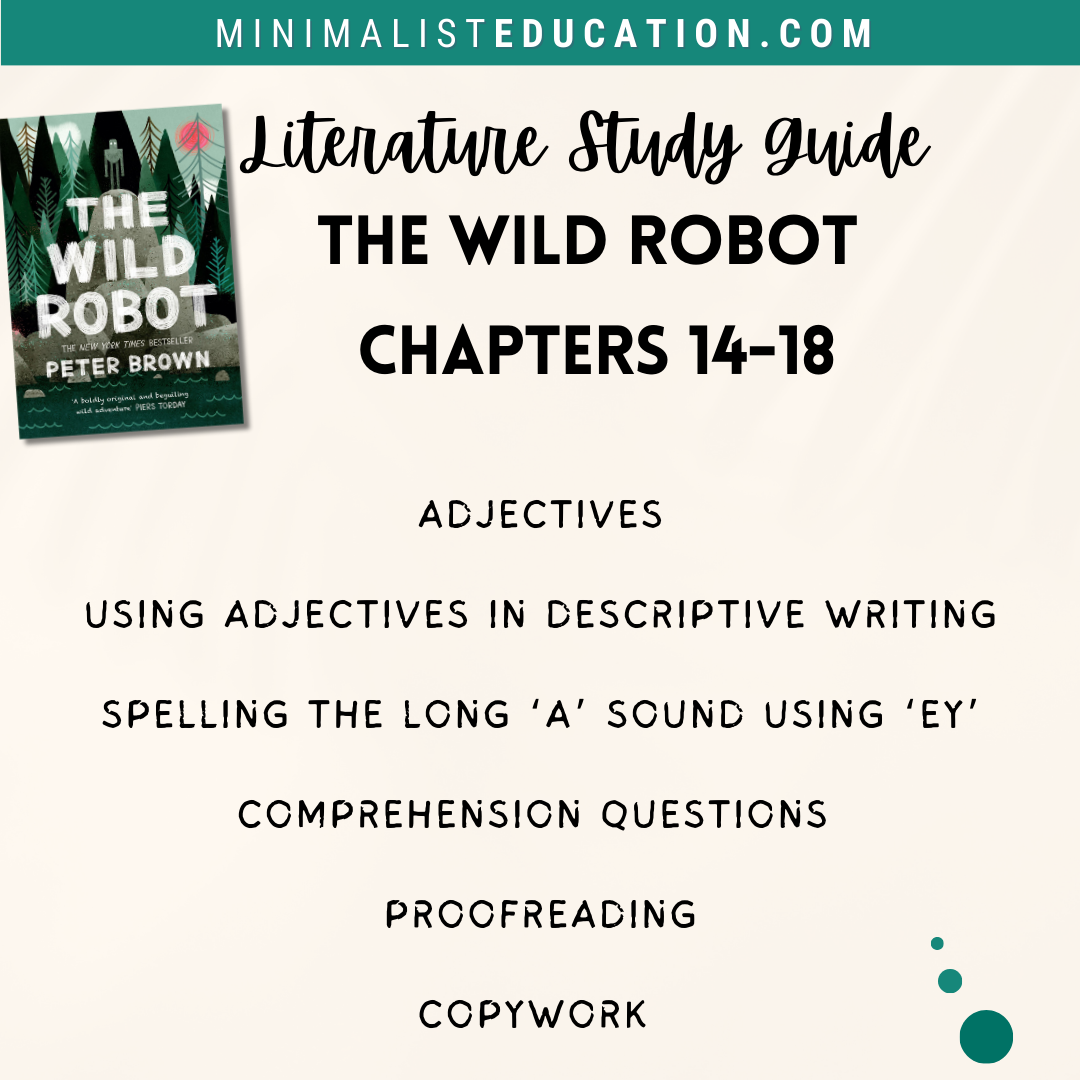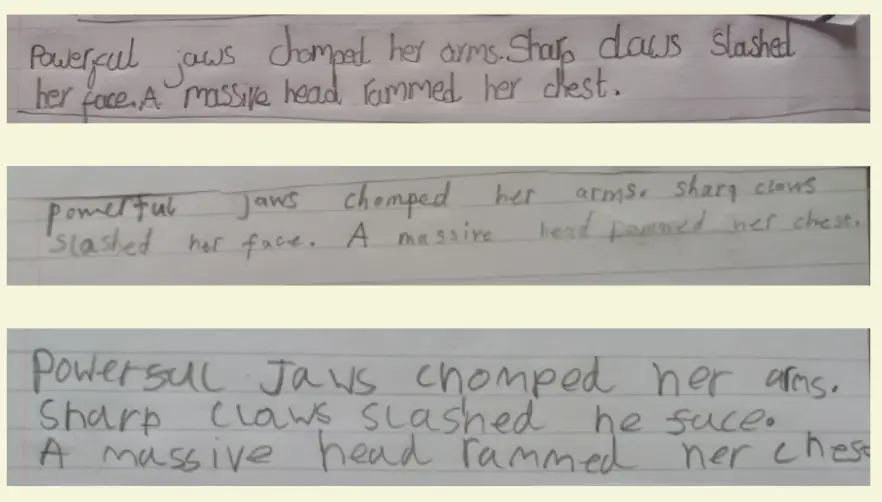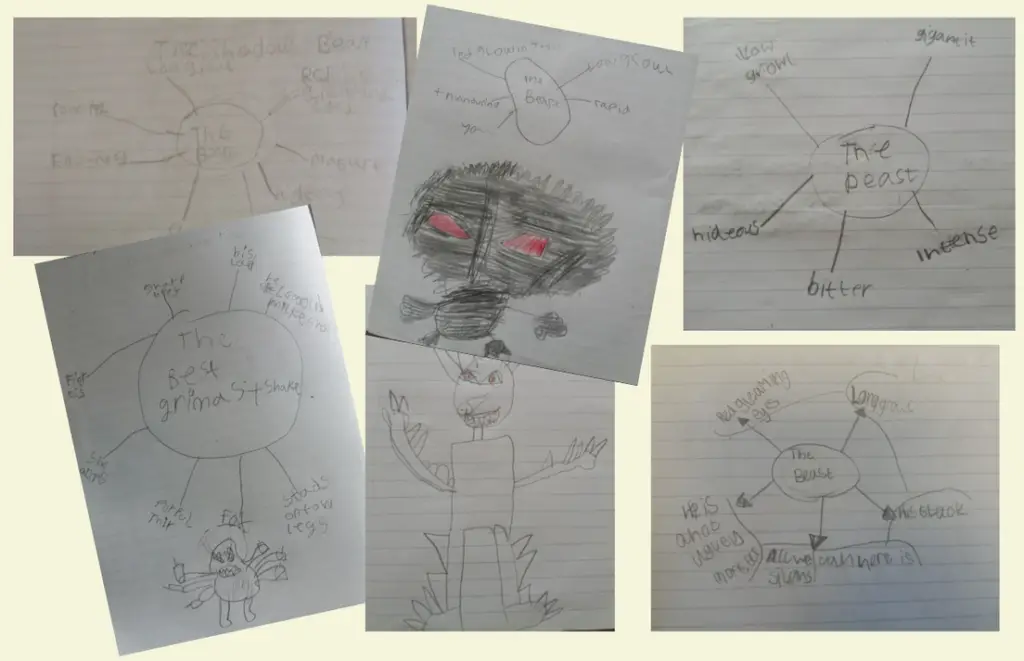A Descriptive Writing Adventure with Adjectives: The Wild Robot Chapters 14-18 Study Guide
This post contains paid links. I may get a commission if you decide to make a purchase through my links, at no extra cost to you. Thank you for helping towards the cost of hosting and maintaining this website.

This week we will uncover the creative and strategic use of adjectives in The Wild Robot by the author, Peter Brown. In this week’s study guide and blog post, we will not only analyse the impact of adjectives in these chapters but also introduce the ‘ey’ spelling rule for the long ‘a’ sound.
Also included are comprehension questions, copywork exercise, and a delightful descriptive writing task where your children will have the opportunity to vividly depict the enigmatic ‘Shadow Beast’ to complete their own narrative.
Read my introduction and find the links to The Wild Robot study guide here.
In this post:
- The Wild Robot teaching notes and answers for Week 3 Chapters 14-18.
- Examples of work produced by children using this guide.
- Download The Wild Robot Study Guide for Week 3 Chapters 14-18.
Get your copy of The Wild Robot
Buy a copy of “The Wild Robot” (Amazon Link).
Any purchase you make using the Amazon links on this site at no extra cost to you. Thank you for helping towards the cost of hosting and maintaining this website.
The Wild Robot Chapters 14-18 Study Guide Teaching Notes And Answers
Read Chapters 14-18:
Read at least a couple of chapters before doing this exercise.
- Ex. 1 Write down some interesting adjectives to go with the following nouns.
Some notes on introducing adjectives
In the first exercise, children practice using adjectives. However, it’s a good idea to practice identifying what adjectives are before children are asked to generate some of their own.
Because I knew the grammar and writing focus this week was going to be on adjectives, I made a big deal of adjectives during the read aloud.
During reading Chapter 14, for example, after reading the lines “she was flying through the air and thumping down onto a rotten log”, I paused and asked what kind of log Roz tripped on. Rotten. We know the log is rotten because the author described the log for us readers. The word rotten describes the noun log – words that describe nouns are called adjectives.
What are words that describe nouns called? Adjectives.
If you do this a few times during the reading, kids will start to gain an intuitive understanding of what adjectives are.
Have a go with your child thinking of your own adjectives.
Keep it simple at the start – pick out nouns that you can see in the room, and then find suitable adjectives.
I think it’s also really important to emphasise why we should even bother to learn about adjectives.
Point out how boring the book would be if Brown didn’t use any adjectives. We readers would have no clue as to what Roz was seeing. It’s because of the adjectives used in the story that we can imagine with such clarity the scenes and events.
If appropriate, you might also want to talk about how many words have ‘synonyms’ – words that have similar meaning to each other.
So instead of using the word big to describe something, we could instead say massive, huge, colossal. Using a variety of different words keeps things interesting and used appropriately, it increases the precision and depth of meaning.
Or you can leave the topic of synonyms for now. There will be plenty of opportunities of picking this topic up later.
After all of this oral practice of what adjectives are, kids can have a go at the fill in the blank exercise where the put suitable adjectives in the sentences.
You can read through the notes on adjectives together. Make sure to point out the comma that is used when listing adjectives, or there is the option of using the word ‘and’ in between the last two adjectives.
- Ex. 2 Answer the comprehension questions based on the five chapters read. These can be discussed first before writing.

- Ex. 3 Learn and practice spelling the long ‘a’ sound using ‘ey’.
We are continuing the spelling rules associated with the long ‘a’ sound.
This week we are focusing on when the long ‘a’ sound (as in “play” or “day”) is spelt with the letter combination ‘ey’.
(Does anyone else find it beyond ridiculous, how there are so many different ways to spell one phonetic sound in the English language?)
This would be an ideal time to review the other ‘a’ spelling rules. Don’t expect perfect recall! But it definitely is a good idea to review the previous rules covered none the less.
Long ‘a’ sounds can be spelt ‘ai’ as in train, rain and pain, or ‘a-e’ as in snake, bake, shake, or ‘ay’ as in play, day and hay, and the rule we did last week, the long ‘a’ sound spelt ‘ei’ as in reindeer, eight and beige.
- Ex. 4 Read the passage. Underline all ten spelling mistakes and write the words out correctly.
This proofreading exercise is also targeting children’s knowledge of spellings. It’s a really helpful skill to build up proofreading and editing skills so that our kids can apply this to their own writing.

- Read the extract and related analysis on adjectives to create suspense.
Powerful jaws chomped her arms. Sharp claws slashed her face. A massive head rammed her chest. Chapter 14 page 34
I selected this extract to highlight this week’s grammar and writing focus on adjectives. I’ve emphasised how writers use adjectives to increase the suspense of a scene.
This passage describes the bears attacking Roz. Brown has used adjectives to create a vivid and intense scene, allowing us to feel the danger and suspense experienced by Roz.
The adjective “powerful“, which described the jaws, intensifies the force of the jaws, giving us a clear sense of the danger and strength of the bears.
“Sharp claws slashed her face.” The adjective “sharp“, which describes the claws, adds to this sense of danger and pain. We can imagine the severity of the claws cutting into Roz’s face, which creates a strong emotional response in us.
The adjective “massive” emphasises the sheer size and weight of the head that collides with Roz’s chest. It conveys a sense of overwhelming force making us feel the impact of the attack.
These adjectives allow us to experience the scene as if we were witnessing it first hand. As a result, this passage becomes more gripping and shocking.
- Ex. 5 Copywork using the extract selected.
- Ex. 6 Write a suspenseful descriptive paragraph about the “Shadow Beast”.
In this creative writing activity, the last task of this week, kids are introduced to the beginning and end of a story.
Beginning: Encounter with the Shadow Beast
In the heart of the ancient forest, I stumbled upon a place that seemed untouched by time. Silence enveloped the air, broken only by the faint rustling of leaves and an occasional hoot of an owl. Suddenly, a chilling sensation crept up my spine. There, emerging from the darkness, was the Shadow Beast.
Ending:
With my heart pounding, I slowly backed away from the creature, leaving the forest with more questions than answers.
What was the Shadow Beast?
I may never know, but the encounter will forever haunt my dreams.
Their task is to write the middle paragraph which will be a description of the ‘shadow beast’. To do this you and your child can brainstorm a list of adjectives for the “Shadow Beast” which creates a sense of mystery and fear.
Think about the creature’s appearance, movements and sounds.
Children can then use this list to write their suspenseful descriptive paragraph about the “Shadow Beast”.
Examples of Children’s Work



Download Your Copy of The Wild Robot Study Guide for Chapters 14-18:
Hopefully by the end of this week’s activities, your child will begin to see that adjectives are indispensable tools in a writer’s tool-kit.
They transform ordinary sentences, making writing more engaging, descriptive, and emotionally resonant.
I hope this has helped some of you out!
Leave a Reply